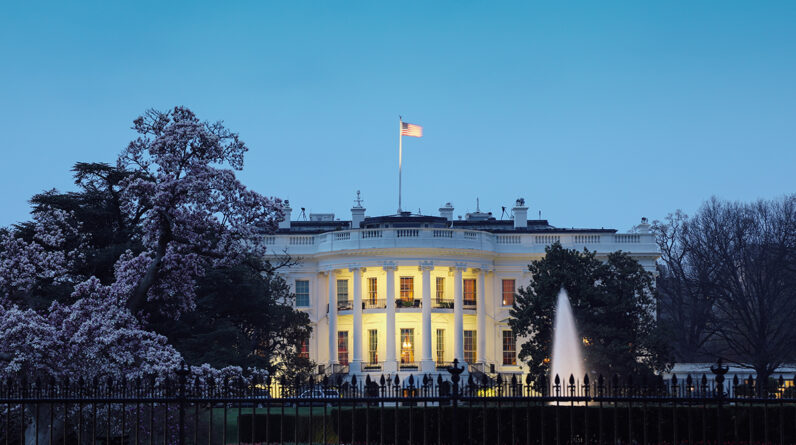
This year, 2023, is the heralded third year of the presidential election cycle. It has kicked off with nervous markets eyeing political drama in Washington, DC: contentious votes to elect the Speaker of the House of Representatives, a combative State of the Union presidential address, partisan threats not to raise the nation’s debt ceiling, and posturing and positioning by lawmakers ahead of the 2024 election. Nevertheless, according to presidential election cycle theory, which was first referenced in the Stock Trader’s Almanac, this third year of the four-year cycle should generate well-above-average stock returns.
So, what are the strengths, limitations, and nuances of presidential election cycle theory and what does the current political context foretell regarding whether 2023 will follow the predicted trend?
The conventional election cycle theory narrative, and why it augurs so well for 2023, goes as follows: “Presidents do the heavy lifting in their first and second year in office and then pivot to preparing for reelection in the fourth year by being friendly to markets in the third year.” Though the data around this may be compelling, the overall narrative warrants some refinement.
The Presidential Election Cycle and S&P 500 Returns

Source: Bloomberg
Since 1928, the third year of the presidential cycle has produced positive S&P 500 returns 78% of the time, generating 13.5% average returns vs. an all-year average of 7.7%. We did not find other coincident indicators in the monetary and fiscal policy signals — rising vs. falling rate environments, for example — that might also offer insights on 2023, but we do believe a party’s degree of government control may be a critical factor. A single party held the “trifecta” of the presidency and House and Senate majorities two-thirds of the time in the first and second years of the cycle, as the Democrats did in 2021 and 2022, but only about one-third of the time in the third and fourth years.
This is a familiar phenomenon in US politics: The president’s party often faces setbacks in the midterm elections. But it also implies that the relevant election cycle may be congressional rather than presidential. Markets may simply be rewarding gridlock. Third years that followed a switch from unified to split government averaged 15.0% returns compared to 10.7% for third years in which the trifecta was preserved. The gridlock question seems important given the likely contrast between 2022’s ambitious legislative agenda and anxiety about potential deadlock in 2023.
The sequence also may be important in anticipating how presidential election cycle theory will play out in 2023. With their glass-half-full outlook, commentators tend to focus on above-average returns in the third year and pay less attention to below-average returns in the second. Second years have accounted for more than one-third of the S&P 500’s total negative return years since 1928 and an even higher proportion of years with materially negative returns, or those like 2022, with worse than –10% performance. The rebound pattern from bearish second to bullish third years is the key sequencing feature. Two down years in a row have only occurred eight times since 1928, and only once, in 1930 and 1931, during the Great Depression, did it happen in the second-to-third-year sequence. So, the second-to-third-year signal may be especially powerful and predictive following such a gloomy 2022.
As such, all the leading indicators of presidential election cycle theory — third year, split government, and dismal second year — would seem to augur well for 2023. But are there any current conditions that might inhibit this predicted strength? Put simply, while the markets may respond well to gridlock, a complete breakdown in government functioning may be a bridge too far.
While fiscal restraint in 2023 after the sizable government largesse of 2022 could have its benefits, total government paralysis and dysfunction — not raising the debt ceiling and not funding the government –may be too much for the markets and economy to bear.
Of course, debt ceiling debates are nothing new in US politics and have yet to lead to catastrophe. But just because they haven’t doesn’t mean that they won’t. So, is this time different? If it is, a particular congressional cohort could be the threshold reason.
In the tightly divided House of Representatives with its narrow Republican majority, the House Freedom Caucus wields considerable influence and can impede legislation in the interest of both diminishing the scope of government and reducing spending. These efforts can also have a performative element that helps caucus members raise their profiles and campaign funds and otherwise build their brands. This latter component may be what most differentiates 2023 from previous third years in the presidential election cycle.
In 2023, as in 2011 and 2013, political drama’s path to economic significance runs squarely through the debt ceiling and federal budget negotiations. The House Freedom Caucus has positioned itself as a key power base in that regard and extracted considerable concessions during the efforts to elect Rep. Kevin McCarthy as Speaker of the House. Among the more significant of these were securing the single-member motion to vacate and gaining several of the nine Republican seats on the 13-seat Rules Committee. These constitute an effective blocking position, or a veto, that will make it very difficult to pass any legislation to raise the debt ceiling without the group’s agreement or acquiescence.
There are few examples in recent political history of similar groups gaining such influence. The difference here is just how performative congressional politics today have become. Amid the rise of social media and a host of other politically centrifugal forces, the threshold for differentiation has moved ever higher, especially amid the 2020 election’s lead-up and aftermath.
To understand just how this performative power may have become the differentiating factor in this presidential cycle’s third year, it helps to conduct a recall experiment. Think of 10 members of Congress. How many of them do you remember for their accomplishments? How many do you remember for their transgressions, obstructions, or theatrics? This explains the risk that successful (not just threatened) confrontations and disruptions can become self-reinforcing phenomena. Or, in an ever-escalating high-stakes game of chicken, what happens if neither side blinks?
There is a counter to all this, of course, and it’s the main reason why 2023 may follow expectations and deliver strong returns. The debt ceiling drama is just that, drama — performance as friction but without the likelihood of causing any lasting damage. The markets may endure some scary moments, but the United States will eventually pay its bills. When flying, turbulence is no fun, but the plane will still land safely.
Several potential steps could help avoid a debt-ceiling impasse. We expect to hear more about the concept of a “discharge petition” and foresee an eventual suspension, though perhaps not an explicit debt-ceiling increase, as a market-acceptable conclusion. The volatility along the way may grab headlines, but there is the underlying and generally stabilizing force of having a coiled spring of 2022 fiscal packages passed in 2022 — the Infrastructure Bill, the CHIPS Act, and the Inflation Reduction Act, or “Build Back Better.” For each of these programs, 2022 may have been the metaphorical architecture phase while 2023 kicks off the building phase, which, all else being equal, should boost nominal activity, jobs, and expenditure.
The heuristics of the Stock Trader’s Almanac thus provide some important insights. Nonetheless, the risks along the way may peak in the lead-up to the fiscal funding deadline in late September, assuming the so-called extraordinary measures to forestall a debt ceiling breach can be extended that far. Thus, it may pay to heed another such heuristic — beware the early fall.
For more on this topic, listen to Michael Edwards’s podcast on the presidential election cycle theory in 2023.
If you liked this post, don’t forget to subscribe to Enterprising Investor.
All posts are the opinion of the author. As such, they should not be construed as investment advice, nor do the opinions expressed necessarily reflect the views of CFA Institute or the author’s employer.
Image credit: ©Getty Images / alexsl
Professional Learning for CFA Institute Members
CFA Institute members are empowered to self-determine and self-report professional learning (PL) credits earned, including content on Enterprising Investor. Members can record credits easily using their online PL tracker.










